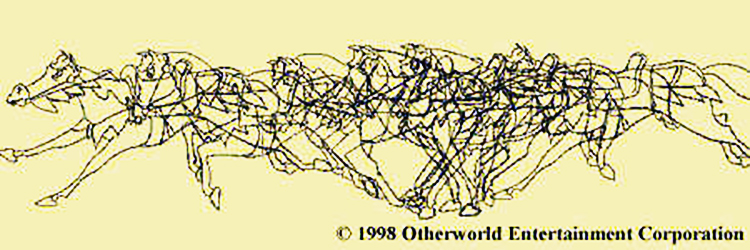 |
Matriculate, Animate . . . or Enlist? |  |
|---|
 |
Matriculate, Animate . . . or Enlist? |  |
|---|

Travis had become somewhat of a loner, attending school regularly and paying attention in class, but steadfastly refused to do homework. It infringed on my studies, Travis says. I had my own curriculum which I pursued avidly. I wanted to write and produce feature length cartoons musical satires, of course. I read all I could find on related subjects and while in high school, did animation for national television advertising campaigns. (He even wrote a medieval musical adventure, first titled Sir Smudge, later retitled The Red-backed, Scaly, Black-bellied, Tusked, Bat-winged Dragon with the idea of making it his first animated feature film. The project, now titled The Long-Grin Saga, continues to evolve. Aurelius Sam Skapars was something of a loner, too. Sam's stepfather was a building contractor and Sam and his brohter, Zinthus, aka "Zeko," made good money as finish carpenters. Somehow, they all became friends at Newton South High School. Sam taught Travis about finish carpentry and Travis taught Sam and Zeko about animation. Sam built Travis' first animation light boxes, as much to see how they worked as anything else, but the first time Travis ran the results of his hours of work, Sam and Zeko were hooked. Both excellent draftsmen, they even assisted Travis when he did the animated portions of the Duncan Yoyo national TV campaign, especially the several seconds of Duncan's Shrieking Sonic Satellite yoyo flying through space. And they taught Travis enough Latvian to get in and out of their house without scaring their grandmother. For a short time, it looked like Travis had the start of something, but his supplies were expensive, assignments were rare, and the pay wasn't nearly as good and regular as finish carpentry. When Travis and Sam graduated from high school, Sam bought himself a new Corvette, and had a well-paying career as a finish carpenter before him. Travis had some cels, some cel paint, some expensive camel hair brushes, a fair supply of Rapidograph pens, some pencils, his own pencil sharpener and about 1,000 sheets of pre-punched cel paper. This was all long before computer animation and basic math was required. There are (still) 24 frames to a second of film (1,440 per minute). Allowing for an average of no more than 4 cel layers per frame, that's 5,760 cels per minute, which, multiplied by 85 minutes, about the average running time for a feature-length cartoon, means 489,600 cels. Cel animation is labor intensive, demanding long hours of meticulous artistry, attention to detail, and not just graphic detail. A rudimentary understanding of physics, keen observation of facial expressions, body language and a profound sense of the ridiculous are also required. Travis's older brother, Jim, after two years at Boston University, joined the army to get his military obligation out of the way and to earn credit toward school through the GI Bill. In the early 60's, the draft hung over young American men who were not going to college like the Sword of Damocles, so after about a six months of scraping, scratching and working incredible hours to keep his little animation company going (all the while everyone was telling him to get a job), Travis followed his brother's example, except that he joined the Navy. Of course, there's more to that story, but it's not important to this article. |